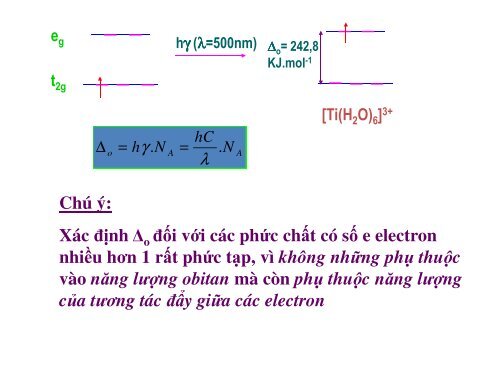Hóa học phức chất
LINK BOX: https://app.box.com/s/kye8plas77zf9d0jn5llx5xrecvyvo22 LINK DOCS.GOOGLE: https://drive.google.com/file/d/1fkbBEmrksxuiIOIhatcSI1ZdIc1TxQHL/view?usp=sharing
LINK BOX:
https://app.box.com/s/kye8plas77zf9d0jn5llx5xrecvyvo22
LINK DOCS.GOOGLE:
https://drive.google.com/file/d/1fkbBEmrksxuiIOIhatcSI1ZdIc1TxQHL/view?usp=sharing
You also want an ePaper? Increase the reach of your titles
YUMPU automatically turns print PDFs into web optimized ePapers that Google loves.
e g<br />
t 2g<br />
hγ (λ=500nm)<br />
∆ o = 242,8<br />
KJ.mol -1<br />
∆<br />
o<br />
=<br />
hC<br />
h γ . N<br />
A<br />
= . N<br />
λ<br />
A<br />
[Ti(H 2 O) 6 ] 3+<br />
Chú ý:<br />
Xác định ∆ o đối với các <strong>phức</strong> <strong>chất</strong> có số e electron<br />
nhiều hơn 1 rất <strong>phức</strong> tạp, vì không những phụ thuộc<br />
vào năng lượng obitan mà còn phụ thuộc năng lượng<br />
của tương tác đẩy giữa các electron

















